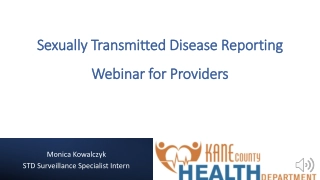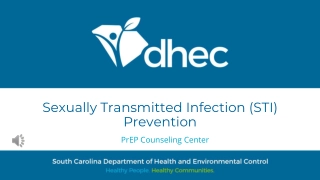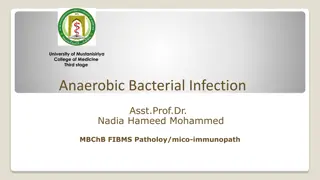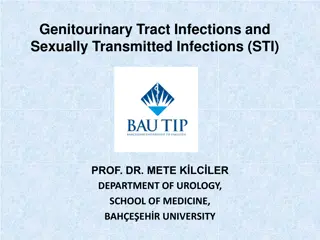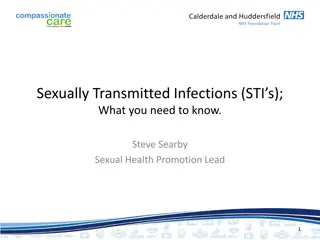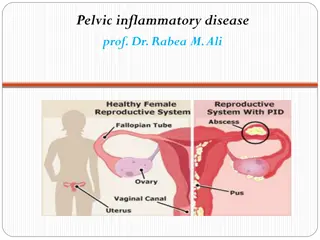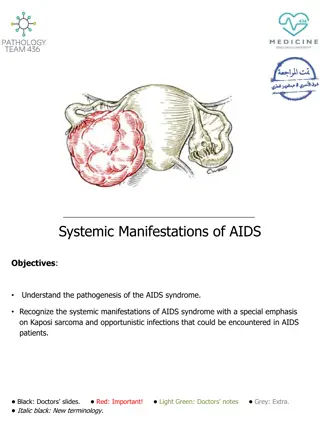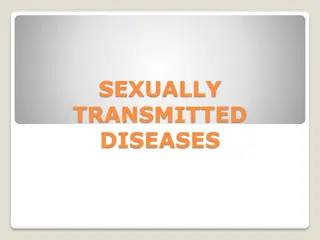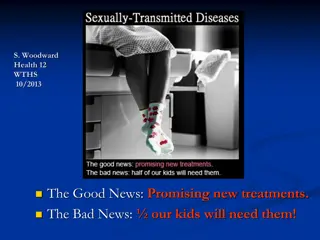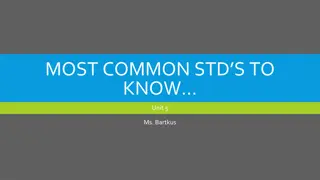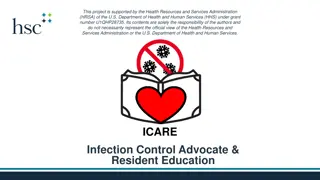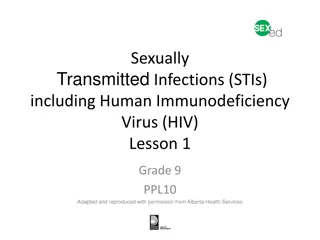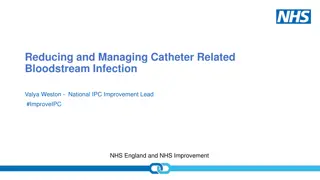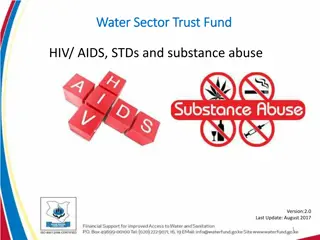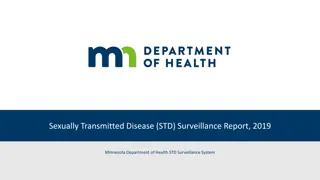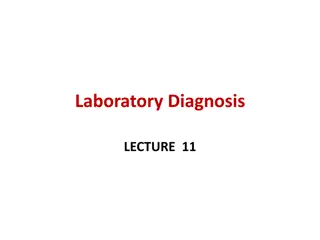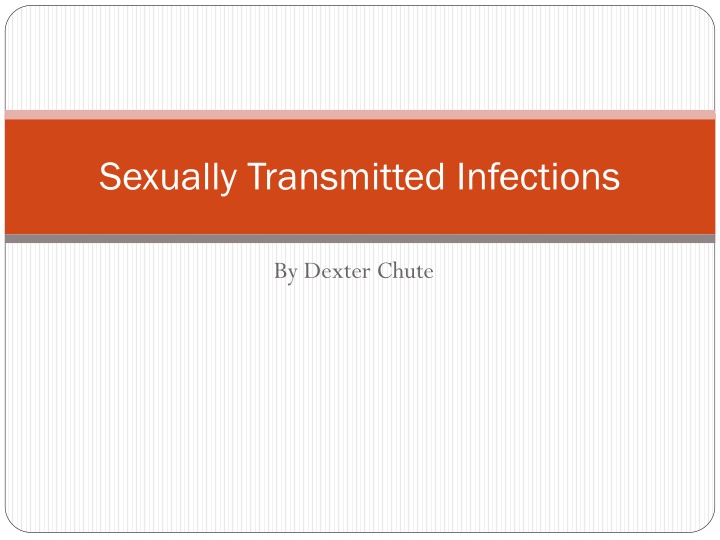
Approaches to Diagnosing Sexually Transmitted Infections
This informative content discusses traditional vs. clinical approaches in diagnosing STIs, highlighting pros and cons of each method. It also introduces syndromic case management and provides guidance on utilizing flowcharts for effective patient care, along with the importance of history-taking and physical examination for accurate diagnosis.
Download Presentation

Please find below an Image/Link to download the presentation.
The content on the website is provided AS IS for your information and personal use only. It may not be sold, licensed, or shared on other websites without obtaining consent from the author. If you encounter any issues during the download, it is possible that the publisher has removed the file from their server.
You are allowed to download the files provided on this website for personal or commercial use, subject to the condition that they are used lawfully. All files are the property of their respective owners.
The content on the website is provided AS IS for your information and personal use only. It may not be sold, licensed, or shared on other websites without obtaining consent from the author.
E N D
Presentation Transcript
Sexually Transmitted Infections By Dexter Chute
Traditional Approaches to Diagnosis AetiologicalApproach Clinical Approach 1. 2.
Aetiological Appraoch Pros Pros Is the ideal method of diagnosis in a perfect setting Helps to identify the exact causative organism Excellent for use in certain circumstances (.eg. Syphillis testing in pregnant women) Cons Cons Specific treatment does not begin until test results come back (patients may continue spreading the disease during this time and also may not wish to return when results are ready) Testing facilities are not readily available in all areas Some organisms are cumbersome to test for given available resources (.eg. H. ducreyi is difficult to culture; Tests for chlamydia is expensive and invasive)
Clinical Approach Pros Pros Cons Cons Excellent approach in areas where lab. Investigations may not be readily available Some STI s present with similar symptoms and may lead the clinician to a wrong diagnosis Depends on clinical experience
Syndromic Case Management Key features: Problem oriented (it responds to patients symptoms) Highly sensitive and does not miss mixed infections Treats the patient at the first visit Makes STI care more accessible as it can be implemented at the primary health care level Uses flowcharts that guide the health worker through logical steps Provides opportunity and time for education and counselling
How to Use a Flowchart Choose the appropriate flowchart that relates to the patients presenting complaint. Follow the flowchart through and manage accordingly The flowchart is simple enough to follow but this does not justify clinicians avoiding its use.
History and Physical Must take into account the individual needs of every patient CONFIDENTIALITY and PRIVACY are KEY!!!! Building rapport: Verbal skills -> how you talk to the patient Non verbal -> how you behave/react to the patient Aims: 1. Make an accurate and efficient syndromic STI diagnosis 2. Establish a patients risk of transmitting or contracting STI s 3. Find out about partners who may have been infected
Treatment Vaginal Discharge Vaginitis -> Flagyl Cervicitis -> AAPA Urethral Discharge -> AAPA Genital Ulcer Syphillis -> Benzathene Penicillin Chancroid -> Herpes -> Aciclovir 1. 2. 3.
Lower Abdominal Pain Gonorrhoea/Chlamydia -> AAPA Mixed Anaerobes -> Flagyl Scrotal Swelling -> AAPA Inguinal Bubo Chancroid -> LGV -> Neonatal Conjunctivitis Gonorrhoea/Chlamydia -> 1% Tetracycline/Silver Nitrate eye ointment 4. 5. 6. 7.
Education and Counselling Importance Knowledge of the disease and its natural process helps improve patient compliance Preventing re-infection can be obtained through sustained behaviour change Education The aim is to make the patient better informed so that she/he can make the patient better informed choice of sexual behaviour and practices The provision of accurate and truthful information so that the person can become more knowledgeable Counselling Relates more to issues of anxiety and coping with the infection or its consequences, biomedically as well as socially Requires empathy, genuineness and the absence of any moral or personal judgement Equipped with the right knowledge, the client should seek to change behaviour as a result of counselling
HIV counselling o The patient must be counselled in such a way that helps them deal with the anxiety of having a life long illness o Proper information should be passed on to the patient to prevent any misunderstanding about the disease How it is spread Its effect on the patients well being The outcome of a HIV infection (AIDS) The difference between HIV and AIDS The management of HIV/AIDS o Informing all high risk patients on the importance of knowing the HIV Status Gaining the patients trust in your confidentiality in order to prevent any stigma
Education on Prevention A few tips! Changing Sexual Behaviour Changing from high-risk to low-risk behaviours Reducing the number of sexual partners/rate of change of sexual partners Condoms Common and effective way of preventing STI transmission Must be able to effectively communicate and educate the patient on correct use of a condom Demonstration of its use where possible (on a model, obviously!) Sexual Practice Informing patients that some sexual practices have a higher risk of STI transmission Anal sex, whether it is man-to-man or man-to-woman, is a high risk sexual practice Personal Hygiene and Cultural Practice Some personal hygiene methods are actually detrimental to health, for example, vaginal douching An example of good personal hygiene is the direction in which women wipe (front-to-back should be the common practice) Washing with soap and water may help prevent colonisation with parasites (.eg. Pubic lice/scabies) 1. o o 2. o o o 3. o o 4. o o o
Some Regional Statistics WHO 2008 WHO estimated that the incidence of selected curable STI s within the Western Pacific Region was 128.2 million This figure was calculated from the incidences of 4 selected diseases (40.0 million C. trachomatis; 42.0 million N. gonorrhoea; 0.5 million Syphillis; 45.7 million T. vaginalis) It was also estimated that at any point in 2008, 37.8 million people had C. trachomatis, 13.3 million people had N. gonorrhoea, 1.2 million people had Syphillis and 30.1 million with T. vaginalis.
Graphical Representation WHO 2008 50 45 40 35 30 Incidence Prevalence 25 20 15 10 5 0 Chlamydia Gonorrhoea Syphillis Trichomoniasis
Annual Health Report MOH for STIs 1400 1200 1000 Gonorrhoea Syphillis Incidence Gonorrhoea Incidence Syphillis 800 600 400 200 0 2010 2011 2012 2013 Incidence rates per 100,000 population
Annual Health Report MOH for HIV 70 60 50 40 Cases Incidence 30 20 10 0 2010 2011 2012 2013 Incidence rate per 100,000 population
What do STIs do to us? Gonorrhoea and Chlamydia have the tendency to ascend the reproductive tract (.eg. Epididymoorchitis/PID/TOA). This leads to further complications as each disease causes damage Syphillis is relatively asymptomatic (.ie. Primary chancre; Secondary asymptomatic; Tertiary Neurological) HIV drops the white cell count causing patients to develop immunocompromisation Stigma against STI s lead to patients who are willing to get tested
Because of these complications, other public health issues can arise 1. MDG 4 Children with HIV are more susceptible to other diseases as well as Failure to Thrive leading to the increase in mortality Under 5 Mortality Rate 22 20 18 Under 5 Mortality Rate 16 14 2010 2011 2012 2013
MDG 5 2. If mothers are booked late or are un-booked, the detection of STI s are significantly reduced during pregnancy MDG 6 Because of stigma, there may be many undetected cases of HIV which may lead to an increase in spread of HIV 3. Contraceptive Prevalence Rate 50.00% 45.00% 44.30% 40.00% 38.40% 36.50% 35.00% Percentage 30.17% 30.00% 25.00% 20.00% 15.00% 10.00% 5.00% 0.00% 2010 2011 2012 2013
Ottawa Charter Building a healthy public policy Policy on Sex Education in schools Prevention of vertical transmission of HIV HIV Care and ART Guidelines HIV Testing and Counselling Policy Create a supportive environment Strict confidentiality and privacy Being supportive and non-judgemental 1. 2.
Strengthening community action Encouraging the community to take an active role in bringing down sex as a taboo topic Encouraging those in the community to come forth with any reproductive health issues (all the while ensuring strict confidentiality and privacy) Develop personal skills Training health workers and affiliates working in close relation to health workers (.eg. Peer educators, Health educators, etc) Workshops to improve/update current knowledge of practitioners Reorient health services Assess the need for increase in resources to this particular problem (compared to other problems) Move any available resources over to help alleviate the problem (.eg. Train more personnel to deal/handle the issue at hand, allocate more of the health budget to the issue) 3. 4. 5.

